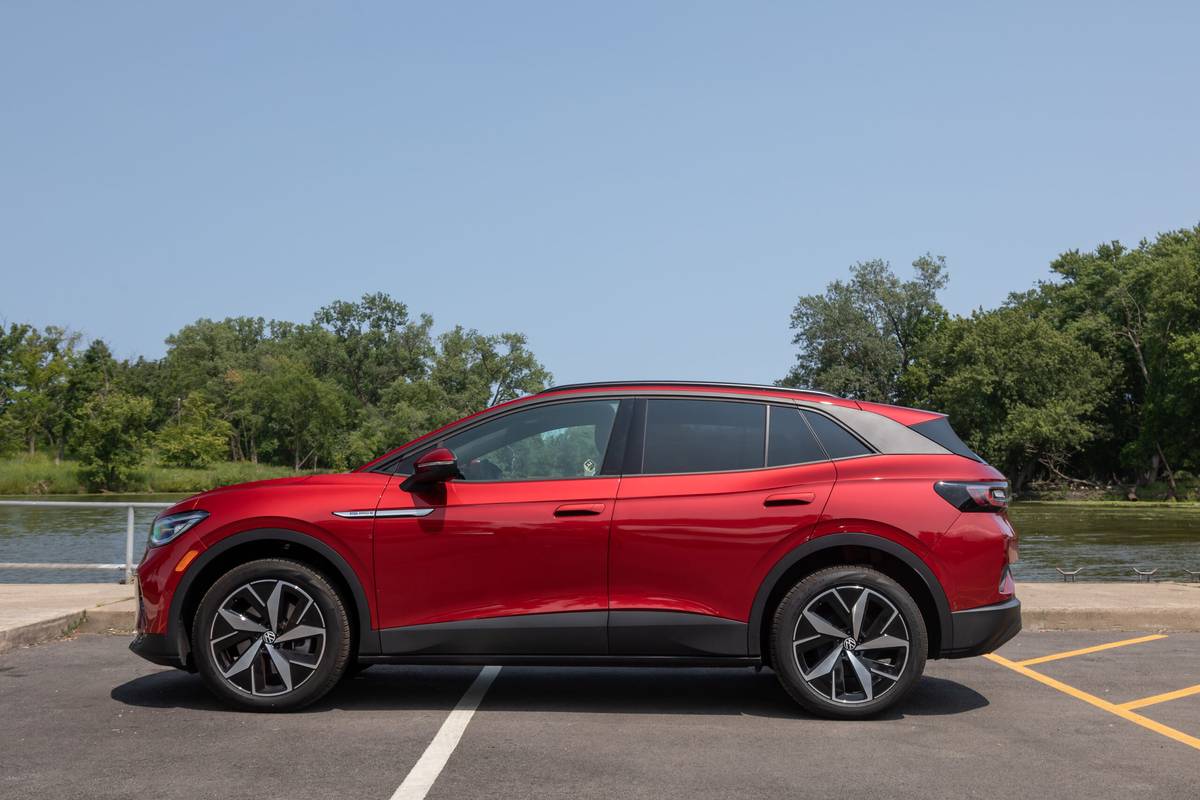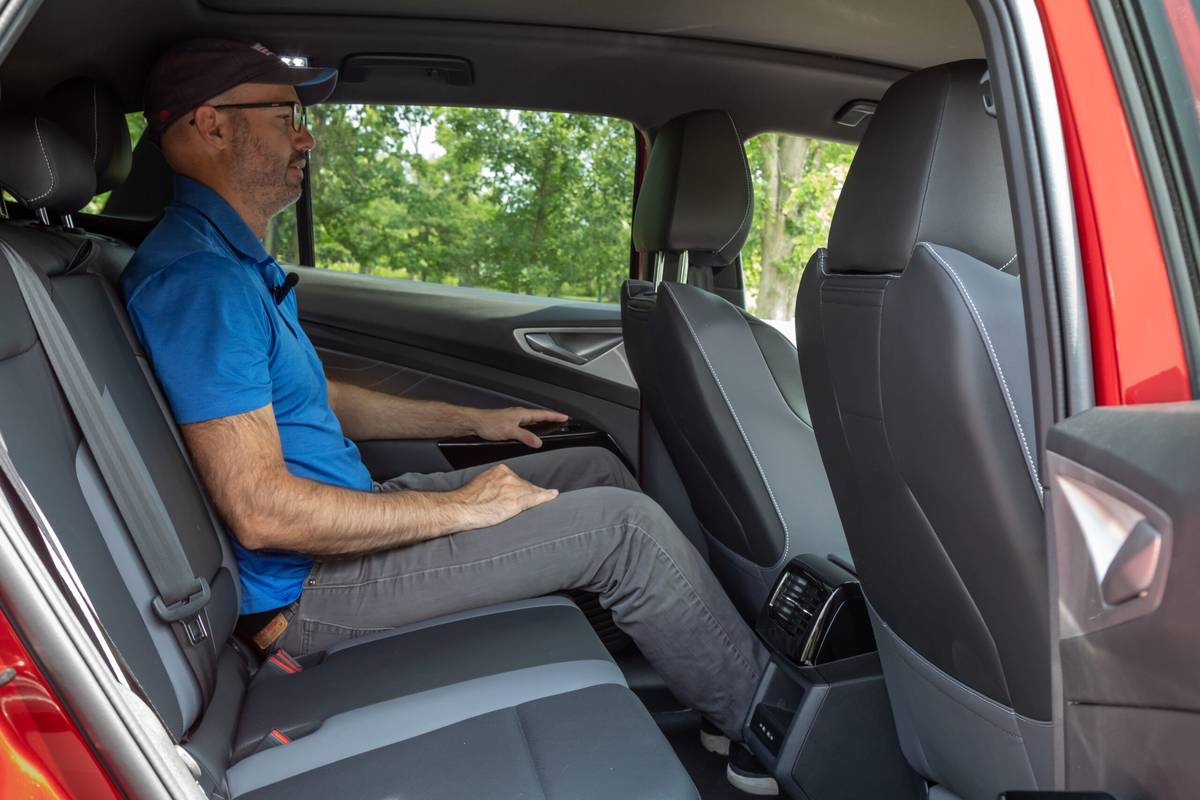Is the 2023 Volkswagen ID.4 a Good Electric SUV? 5 Pros, 3 Cons

Launched as a 2021 model, the Volkswagen ID.4 is an all-electric compact SUV designed to offer buyers in an increasingly crowded field something with distinct VW flavor and driving dynamics. The ID.4 largely succeeds at its mission, and a lower-priced version for 2023 followed by more updates for 2024 only add to the appeal. But the ID.4 is saddled with touch-sensitive controls that are frustrating and distracting enough that they keep a good electric SUV from being great.
- ${price_badge()}
- ${battery_badge()}${ev_report_link()}
- ${hot_car_badge()}
- ${award_badge()}
- ${cpo_badge()}
${price_badge_description}
The EV Battery Rating is based on this vehicle's current expected range relative to the vehicles expected range when new. ${battery_badge_text}
Certified cars are manufacturer warrantied and typically go through a rigorous multi-point inspection.
This car is likely to sell soon based on the price, features, and condition.
${award_blurb}
${award_two_blurb}
Shop the 2023 Volkswagen ID.4 near you

With its lively performance, helpful trip-planning technology, and a spacious and comfortable interior, the ID.4 comes well positioned to compete with other electric vehicles like the Ford Mustang Mach-E, Hyundai Ioniq 5 and Nissan Ariya. Volkswagen is building on that with added features and the availability of more power for the 2024 model year.
Unfortunately, those virtues are largely overshadowed by the ID.4’s frustrating controls, as Cars.com Senior Road Test Editor Mike Hanley found while spending time with an all-wheel-drive 2023 ID.4 in the Pro S trim. Tap the link above for his expert review; for a quicker look, here are five things we like about the 2023 Volkswagen ID.4 and three things we don’t.
Things We Like

1. Not Too Stiff
The Pro S trim comes with 20-inch wheels and tires, a setup that can often result in a stiffer ride when compared with smaller wheels with taller-sidewall tires. But thanks to an impressive job of chassis tuning, the ID.4 rides reasonably well, with only some harshness over rough pavement. Overall, the ride is considerably more comfortable than the Mustang Mach-E’s, if not as absorbent as the Ioniq 5’s.
2. Plentiful Power
With its dual-motor drivetrain good for a total of 295 horsepower, our ID.4 Pro S test car delivered smooth, immediate power, making for effortless acceleration whether darting through city traffic or on the open road. On the highway, there’s adequate power in reserve for drama-free merging and passing.
3. Good Visibility
Thin front roof pillars, big side mirrors and large side windows make it easy to see what’s around you, and a large, vivid backup camera view helps with visibility while backing up and parking. The large B-pillars can make it harder to see what’s over your shoulder, but a standard blind spot warning system helps make up for that.
4. Travel-Ready Touchscreen
The standard 12-inch touchscreen provides sharp graphics and resolution and comes with wireless Android Auto and Apple CarPlay. The system is easy enough to use, although it would be better with physical controls for audio volume and tuning. Navigation is standard, and it includes a trip-planning feature that not only displays places to stop and charge the ID.4, but how long each charging stop should take, as well.
5. Room to Move
The ID.4’s cabin is roomy enough to comfortably accommodate adults of all sizes, and that’s true even when taller people are seated in both rows at the same time. Backseat room is particularly good for the class. The Pro S trim has simulated leather seats, and the front seats are heated but not ventilated on 2023 models. That changes for the 2024 version, which has available ventilated seats.
More From Cars.com:
- Volkswagen to Roll Out Plug&Charge for 2023 ID.4
- How Do Car Seats Fit in a 2023 Volkswagen ID.4?
- 2024 Volkswagen ID.4: More Power, $41,160 Base Price
- Research the Volkswagen ID.4
- Find Your Next Car
Things We Don’t Like

1. Spongy Brake Pedal
In normal Drive mode, the ID.4 coasts like a conventional vehicle when you take your foot off the accelerator, without the more aggressive regenerative braking that’s common with some EVs. In this mode, the brake pedal feels numb and spongy when bringing the vehicle to a halt. The braking is largely handled by the electric motors, with the conventional brakes activating only when more stopping power is needed. Switching to Brake mode ratchets up the regenerative braking, but it’s not enough to bring the ID.4 to a complete stop without tapping the brake pedal.
2. Touchy Subject
Screen-based touch controls work well enough if properly designed, but touch controls outside the environment of a touchscreen are another matter. The ID.4’s cabin is a rolling illustration of this and is packed with touch-sensitive controls on the dash, touchpads instead of buttons on the steering wheel, and more of the same for the driver’s door-mounted mirror and lock controls. None are as intuitive or easy to use as conventional knobs or buttons.
3. Short on Switches
Another notably odd choice on the controls front is VW’s decision to not include switches for each of the four power windows on the driver-side door, opting instead to provide only two switches and another touch-sensitive control to select between the front or rear windows. Whether a cost-cutting move or one intended to create a more minimalist look, we’d rather Volkswagen go back to using separate switches for each window.
Related Video:
Cars.com’s Editorial department is your source for automotive news and reviews. In line with Cars.com’s long-standing ethics policy, editors and reviewers don’t accept gifts or free trips from automakers. The Editorial department is independent of Cars.com’s advertising, sales and sponsored content departments.
Featured stories




